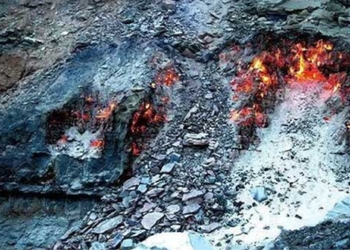On March 4, scientists announced the first in-depth research study on star-shaped dunes in the desert, revealing the internal structure of these geological features as well as their formation process.
Star-shaped dunes are considered one of the wonders of the desert. These pyramid-shaped sand formations can reach heights of up to 300 meters, and from above, they resemble stars.

The Lala Lallia Dune stands about 100 meters above the surrounding dunes and spans approximately 700 meters, containing over 5 million tons of sand. (Photo: Reuters).
The study focused on a star dune in eastern Morocco named Lala Lallia, which in the local Berber language means “the highest sacred point”. This dune is located in the Sahara Desert at Erg Chebbi, an area rich in sand dunes formed by desert winds, about 5 kilometers from the town of Merzouga, near the border with Algeria. The Lala Lallia Dune stands about 100 meters tall compared to the surrounding dunes and is approximately 700 meters wide, containing more than 5 million tons of sand.
Researchers employed ground-penetrating radar to observe the interior of the dune, alongside optically stimulated luminescence dating to determine the time of formation of Lala Lallia. Optically stimulated luminescence dating is a method based on the amount of energy trapped within sand grains. The results revealed that the formation process of the Lala Lallia Dune spanned 900 years, with around 6,400 tons of sand accumulating each year due to the continuous winds blowing across the desert.
By utilizing ground-penetrating radar, scientists discovered how the internal layers of the Lala Lallia Dune have been formed over time through sand accumulation and the similarities between the internal structures of this dune and other dunes.
Charlie Bristow, a sediment researcher and co-author of the study from Birkbeck, University of London, stated that dunes are formed in areas with complex wind patterns, meaning winds blowing from various directions. The researchers also identified that the Lala Lallia Dune is moving westward at a rate of about 0.5 meters per year.
Star dunes account for less than 10% of the dunes in the deserts on Earth and are the tallest dunes, surpassing other types such as barchan and linear dunes. Star dunes have also been discovered on Mars and Saturn’s moon Titan.
The largest star dunes on Earth are found in the Badain Jaran Desert in western China. Additionally, star dunes exist in various locations, including the Namib Sand Sea in Namibia, large dune regions in Algeria such as the Grand Erg Oriental and Grand Erg Occidental, and the Rub’ al Khali in Saudi Arabia.
Despite the many known dunes, only one ancient dune has been discovered in the form of sandstone, dating back approximately 250 million years, in Scotland. Researchers indicate that understanding the internal structure of dunes may help geologists identify remnants of ancient star dunes.





















































